Note: The Institute of Heraldry (TIOH), the authorizing agency for determining the medals and decorations that will be issued to Army veterans through the Veteran Medals Program, implemented a change to the finish of US Army badges. The current silver oxide finish is being phased-out and a nickel-plated shiny finish is being introduced. The transition to the new finish is expected to begin in October 2017. The Veteran Medals Team will make every effort to ensure the finish is the same for all Army badges included in an awards case.
AIR ASSAULT BADGE
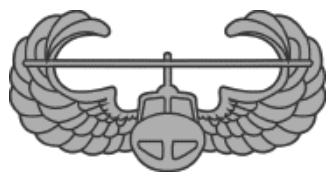
DESCRIPTION: An oxidized silver badge 3/4 inch in height and 1 17/32 inches in width, consisting of a helicopter, frontal view, superimposed upon a pair of stylized wings displayed and curving inward.
SYMBOLISM: The wings suggest flight and together with the helicopter symbolize individual skills and qualifications in assault landings utilizing the helicopter.
AWARD ELIGIBILITY: Awarded by commanders of divisions and separate brigades to individuals who satisfactorily complete an air assault training course in accordance with the U.S. Army Training and Doctrine Command’s Standardized Air Assault Core Program of Instruction. Also authorized for any individual who has satisfactorily completed the Standard Air Assault Course when assigned or attached to the 101st Airborne Division (Air Assault) since 1 April 1974.
DATE APPROVED: The Air Assault Badge was approved by the Chief of Staff, Army, on 18 January 1978, for Army-wide wear by individuals who successfully completed Air Assault training after 1 April 1974. The badge had previously been approved as the Airmobile Badge authorized for local wear by the Commander of the 101st Airborne Division, effective 1 April 1974.
SUBDUED BADGE: Subdued badges are authorized in metal and cloth. The metal badge is black. The cloth badge is of olive drab base cloth with design elements embroidered in black.
MINIATURE BADGES: A miniature badge, 7/16 inch in height and 7/8 inch in width is authorized.
ARMY ASTRONAUT DEVICE AND BADGES
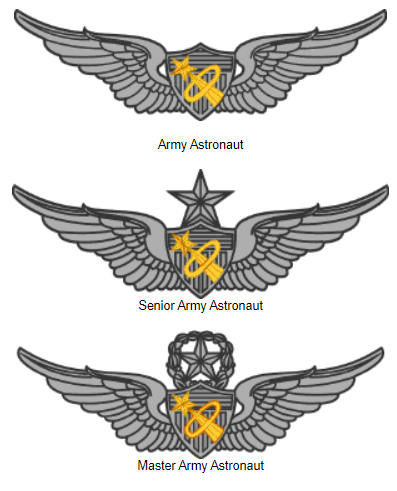
DESCRIPTION: A gold colored stylized shooting star with three contrails enfiling an elyse saltirewise. The device is placed on the appropriate existing aviation badges.
SYMBOLISM: The badge design is the same as that for Army Aviation (aviator, flight surgeon, crewmember, etc.) with the shooting star and elliptical orbit superimposed over the shield. The shooting star passing through the elliptical orbit implies space and the astronaut’s theatre of operations.
AWARD ELIGIBILITY: The appropriate Astronaut Badge may be awarded to any individual who has been awarded any one of the Army Aviation Badges as specified in AR 600-8-22, and who completes a minimum of one operational mission in space (50 miles above earth). Astronauts, who have not been awarded an aviation badge previously, will be awarded the crewmember badge.
DATE APPROVED: The Army Astronaut Device was approved on 17 May 1983.
SUBDUED BADGES: Subdued badges are authorized in metal and cloth. The metal badge is black with brown device. The cloth badge is of olive green base cloth with design elements embroidered in black. The astronaut device is brown.
MINIATURE BADGES: Dress miniature badges are authorized for each of the astronaut badges.
ARMY AVIATOR BADGES
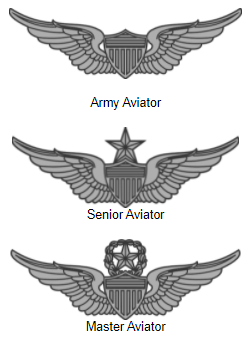
DESCRIPTION: An oxidized silver badge 3/4 inch in height and 2 1/2 inches in width, consisting of the shield of the coat of arms of the United States on and over a pair of displayed wings. A star is added above the shield to indicate qualification as a Senior Army Aviator. The star is surrounded with a laurel wreath to indicate qualification as a Master Army Aviator.
SYMBOLISM: The wings suggest flight and reflect the skills associated with aerial flight. The shield of the coat of arms of the United States signifies loyalty and devotion to duty.
AWARD ELIGIBILITY:
Army Aviator: An individual must have satisfactorily completed the prescribed training and proficiency tests, and must have been designated as an aviator in orders issued by the appropriate headquarters as outlined in AR 600-105.
Senior Aviator: An aviator, who is medically qualified and instrument qualified may apply for the Senior Aviator Badge as long as the aviator has served seven years of rated aviation service, served 84 months in operational flying duty assignments and accumulated 1,000 hours of flight time.
Master Aviator: A Senior Aviator, who is medically qualified and instrument qualified may apply for the Master Aviator Badge as long as the aviator has served fifteen years of rated aviation service, served 120 months in operational flying duty assignments and accumulated 2,000 hours of flight time.
DATE APPROVED: The Aviator and Senior Aviator Badges were approved on 27 July 1950 and the Master Aviator Badge was approved on 12 February 1957.
SUBDUED BADGES: Subdued badges are authorized in metal and cloth. The metal badge is black; the cloth badge is of olive green base cloth with design elements embroidered in black.
MINIATURE BADGES: Dress miniature badges are authorized in the following sizes: Aviator – 21/64 inch in height and 1 1/4 inches in width; Senior Aviator – 13/32 inch in height and 1 1/4 inches in width; Master Aviator – 15/32 inch in height and 1 1/4 inches in width. Miniature badges are 19/32 inch in height and 2 inches in width; 11/16 inch in height and 2 inches in width; and 23/32 inch in height and 2 inches in width, respectively.
ARMY STAFF IDENTIFICATION BADGE
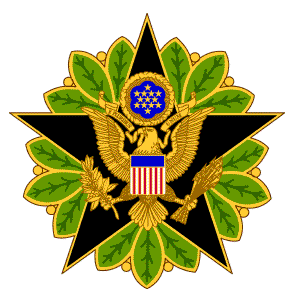
DESCRIPTION: The Coat of Arms of the United States in gold with the stripes of the shield to be enameled white and red and chief of the shield and the sky of the glory to be enameled blue, superimposed on a five-pointed black enameled star; in each reentrant angle of the star are three green enameled laurel leaves. The star is 3 inches in diameter for the Chief of Staff and former Chiefs of Staff and a 2 inches in diameter badge is authorized for all other personnel awarded the badge.
SYMBOLISM: The badge is based on the General Staff insignia with a black star in lieu of the Silver Star. The addition of the laurel leaves indicate achievement.
AWARD ELIGIBILITY: The requirements as listed in Chief of Staff Regulation 672-5, authorized award of the Army Staff Identification Badge for one year of service while assigned to the Army General Staff. The badge is authorized for officers and E-9s assigned to authorized positions at Headquarters, Department of the Army. Civilian personnel in grades GS-11 and above may be awarded a lapel button upon completion of at least one year of service.
DATE APPROVED: The badge was first proposed by General MacArthur, while Chief of Staff, in a conversation with Brigadier General Andrew Moses, then Assistant Chief of Staff, G1, War Department General Staff, on 28 December 1931. Subsequently, the badge was designed by the Office of the Quartermaster General and approved by the Chief of Staff, General MacArthur, on 28 July 1933. It was announced on 23 August 1933 in War Department Circular No. 45 and award was made retroactive to 4 June 1920. Sergeants Major were authorized to be awarded the badge effective 30 September 1978 and the effective date for Warrant Officers was 22 August 1979. The lapel button for civilian personnel in the grade of GS-11 and higher was authorized effective 1 July 1982. The Army Chief of Staff, General Wickham, also approved a change in the name of the badge from Army General Staff Identification Badge to Army Staff Identification Badge.
SUBDUED BADGE: The Army Staff Identification Badge is not authorized to be worn or manufactured in a subdued version.
MINIATURE BADGES: A miniature badge with 7 stripes in the chief instead of 13 stripes and 1 ½ inches in diameter was authorized on 23 June 1989.
Aviation Badges
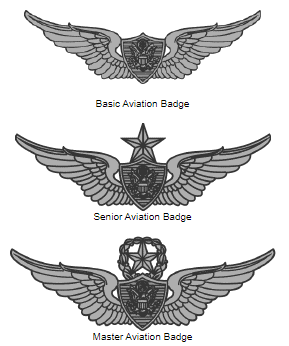
DESCRIPTION: An oxidized silver badge 3/4 inch in height and 2 1/2 inches in width, consisting of a shield with its field scored with horizontal lines and bearing the coat of arms of the United States on and over a pair of displayed wings. A star is added above the shield to indicate the degree of Senior Aviation Badge and the star is surrounded with a laurel wreath to indicate the degree of Master Aviation Badge.
SYMBOLISM: The badge is the same design as that for Army Aviator with the coat of arms of the United States substituted for the shield of the coat of arms of the United States. The wings suggest flight and reflect the skills associated with aerial flight. The coat of arms of the United States on the shield signifies loyalty and devotion to duty.
SPECIAL POLICY:
(a) The retroactive date for these badges is 1 Jan 1947;
(b) The Master Aviation Badge and Senior Aviation Badge are authorized for permanent wear. The Basic Aviation Badge may be authorized for temporary or permanent wear. An officer awarded an Aviation Badge while serving in an enlisted status is authorized to wear the badge as a permanent part of the uniform;
(c) Permanent award of the Basic, Master, and Senior Aviation Badges will be announced in Permanent Orders by commanders authorized to approve the award.
AWARD ELIGIBILITY: The badges are awarded in degrees to personnel who have met the following requirements:
BASIC AVIATION BADGE - PERMANENT AWARD:
(a) Individual must be on flying status as a crewmember in accordance with AR 600-106 or be granted a waiver by HQDA, be on flying status, have performed in-flight duties for not less than 48 flight hours (whichever comes first), or be school trained;
(b) An officer on flying status as an aerial observer. U.S. Army personnel assigned to a Joint Service Airborne Command Post and serving as members of an operational team on flying status manning the Airborne Command Post. Concurrent with such assignment, personnel are authorized temporary wear of the Basic Aviation Badge until relieved from such duties or until he or she fulfills the mandatory requirements for permanent award;
(c) Individual who has been incapacitated for further flight duty by reason of being wounded as a result of enemy action, or injured as the result of an aircraft accident for which he or she was not personally responsible, or has participated in at least 15 combat missions under probable exposure to enemy fire while performing in-flight duties;
(d) Soldiers upon successful completion of formal advanced individual training (AIT) in career management field (CMF) 67 and 93 MOS', MOS 71P, and to soldiers who previously completed AIT in CMF 28 MOS', including soldiers who graduated from AIT for MOS' in the 68 series. Soldiers holding MOS's 35L, 35M, 35Q, and 35W who graduated from a (CMF) 67 AIT prior to 30 September 1996 and MOS's 93C and 93P who graduated from a (CMF) 67 AIT after 31 December 1985 are authorized based on documents prior AIT;
(e) Individuals who meet criteria for award of the Army Astronaut Device and are not authorized an Aviator, Flight Surgeon or Aviation Badge will be awarded the Aviation Badge in addition to the Army Astronaut Device;
(f) The Aviation badge may be permanently awarded to soldiers upon successful completion of formal AIT in (CMF) 93 MOS'. Soldiers previously holding MOS 93B who graduated from a (CMF) 93 AIT prior to 1 January 1998 and soldiers previously holding MOS 93D who graduated from a (CMF) 93 AIT prior to 30 September 1996, to include MOS 71P who graduated from a (CMF) 93 AIT prior to 30 June 1984, are authorized the badge based on documented AIT after 7 April 1983.
BASIC AVIATION BADGE - TEMPORARY AWARD:
The commander of any Army unit that has Army aircraft assigned may authorize in published orders qualified personnel of his or her command to wear the Aviation Badge. The individual must be performing in-flight duties.
SENIOR AVIATION BADGE:
Individual must either successfully perform 7 years on flight status in a principal duty assignment described in AR 600-106. Soldiers in (CMF) 67 and 93, or MOS 71P, including all 68 series MOS', Warrant Officer MOS' 150A and 151A, and MOS 00Z, individuals from (CMF) 67 or 93 field, or MOS 71P field, may qualify with 10 years of experience if they meet the following criteria:
(a) Only time involving frequent and regular flights will be counted toward fulfillment of this requirement, except that time involved in transit between PCS assignments to include TDY, will also be credited;
(b) Soldiers who retain (CMF) 67 or 93, or MOS 71P, while performing career progressive assignments, especially duties as Drill Sergeant, Recruiter, Career Management NCO, Career Advisor, Instructor or Equal Opportunity Advisor will be counted towards this requirement not to exceed 36 months. Warrant Officers MOS 150A or 151A may qualify after successfully performing 7 years on flight status or 10 years experience in (CMF) 67 or 93, or MOS 71P, MOS 151A or 150A. Prior enlisted (CMF) 67, to include MOS 71P, time may count with MOS 151A experience and (CMF) 93 time may count with MOS 150A experience to fulfill this requirement. The retroactive date for this badge under these criteria is 7 April 1983;
(c) Displayed complete competence in the principal duty or duties performed leading to this award;
(d) Be recommended by the unit commander of the unit to which presently assigned. Retroactive Award. The retroactive date for award of this badge is 7 April 1983 for (CMF) 93, MOS 71P, Warrant Officer MOS 150A and 151A and individuals in MOS 00Z. Soldiers holding (CMF) 93 or MOS 93D, prior to 30 September 1996 and MOS 93B prior to 1 January 1998, to include MOS 71P prior to 30 June 1984 may qualify for award of the Senior Aviation Badge based on documented experience.
MASTER AVIATION BADGE:
Individual must successfully perform 15 years on flight status in a principal duty assignment described in AR 600-106. Soldiers in (CMF) 67 and 93, or MOS 71P, including all 68 series MOS', Warrant Officer MOS' 150A and 151A, and MOS 00Z, individuals from (CMF) 67 or 93 field, or MOS 71P field, may qualify with 17 years of experience if they meet the following criteria:
(a) Only time involving frequent and regular flights will be counted toward fulfillment of this requirement, except that time involved in transit between PCS assignments, to include TDY, will also be credited;
(b) Soldiers who retain (CMF) 67 or 93, or MOS 71P, while performing career progressive assignments, especially duties as Drill Sergeant, Recruiter, Career Management NCO, Career Advisor, Instructor or Equal Opportunity Advisor will be counted towards this requirement not to exceed 36 months. Warrant Officers MOS 150A or 151A may qualify after successfully performing 15 years on flight status or 17 years experience in (CMF) 67 or 93, or MOS 71P, MOS 151A or 150A. Prior enlisted (CMF) 67 time, to include MOS 71P, may count with MOS 151A experience and (CMF) 93 time may count with MOS 150A experience to fulfill this requirement;
(c) Displayed complete competence in the principal duty or duties performed leading to this award;
(d) Attained the grade of E-6 or higher;
(e) Be recommended by the unit commander and endorsed by the next higher commander of the unit to which presently assigned.
RETROACTIVE DATE: The retroactive date for the badge under these revised criteria is 1 January 1976. The retroactive date for (CMF) 93, MOS 71P, Warrant Officer MOS' 150A and 151A and individuals in MOS 00Z is 7 April 1983. Soldiers holding (CMF) 93, MOS 93D, prior to 30 September 1966 and MOS 93B, prior to 1 January 1998, to include MOS 71P prior to 30 Jun 1984 may qualify for award of the Master Aviation Badge based on documented experience.
DATE APPROVED: The Aviation Badge was originally approved as the Aircraft Crew Member Badge by the Deputy Chief of Staff for Military Operations on 16 May 1962. The Deputy Chief of Staff approved the change to the present Aviation Badges on 29 Feb 2000 retroactive to 1 Jan 1947 for Military Personnel.
SUBDUED BADGES: Subdued badges are authorized in metal and cloth. The metal badge is black. The cloth badge is of olive green base cloth with design elements embroidered in black.
MINIATURE BADGES: Dress miniature badges are authorized in the following sizes: Basic Aviation Badge - 21/64 inch high and 1 1/4 inches wide; Senior Aviation Badge - 13/32 inch high and 1 1/4 inches wide; and Master Aviation Badge - 15/32 inch high and 1 1/4 inches wide. Miniature badges for the three degrees are authorized in the following sizes: 19/32 inch high and 2 inches wide; 11/16 inch high and 2 inches wide; and 23/32 inch high and 2 inches wide, respectively.
CAREER COUNSELOR BADGE
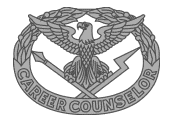
DESCRIPTION: An oxidized silver badge 1 7/8 inches in height overall consisting of an eagle with raised and outstretched wings standing upon, at the point of the intersection, the shaft of a spear to the left and the barrel of a musket with fixed bayonet to the right, weapons terminated just below the point of crossing, and all enclosed by a horizontal oval-shaped frame, its lower half consisting of a scroll inscribed with the words "CAREER COUNSELOR" in raised letters, the upper half composed of two olive branches issuing from the ends of the scroll at either side and passing behind the eagle's wing tips, meeting at top center; all areas between the eagle, spear and musket and the frame are pierced.
SYMBOLISM: The spear and musket from the seal of the Department of the Army symbolize the role of the Army in national defense and the many specialized requirements served by the activities of the Career Counselor. The eagle is a national emblem and the branches of olive suggest service in peacetime as well as in war.
AWARD ELIGIBILTY:
a. Authorized for wear by enlisted personnel assigned to authorized duty positions which require PMOS 79S (Career Counselor). Officers are authorized to wear the badge if they held an authorized retention PMOS and met the criteria in paragraph d1 below while in an enlisted status.
b. The award is retroactive to 1 Jan 1972 for soldiers who currently hold PMOS 79S or previously held PMOS 79D or PMOS OOR (Retention NCO) or PMOS OOE (In-Service Recruiter/Transition NCOI RC Career Counselor) and meet the criteria or permanent award outlined below.
c. Authorization of the badge as a uniform item will be announced by commanders of units of battalion size or larger. Temporary wear of the badge is authorized for soldiers who meet one of the following requirements:
(1) Served less than 12 months as PMOS 79S Career Counselor since graduation from the Army Retention Course.
(2) Served less that 12 months as Active Guard/Reserve (AGR) Career Counselor (PMOS 79S).>br>
(3) Serve as Army Reserve Reenlistment NCO according to paragraph f1 below.
d. Permanent wear of the badge is authorized for soldiers who meet one of the following requirements:
(1) For Regular Army, successfully completes 12 months as PMOS 79S Career Counselor since graduation from the resident Army Retention Course.
(2) For USAR or ARNG, successfully completes formal resident training and 12 months in a primary duty MTOE/TDA retention coded position (PMOS 79S or other previously assigned retention MOS).
(3) Soldiers, whether RA, USAR or ARNG, who have been awarded a secondary MOS of 79S as a result of formal resident training and have performed duties as a Career Counselor in a valid MTOE or TDA 79S position for a period of 12 consecutive months.
e. Commanders in the rank of Colonel or higher may authorize the wear of the Career Counselor Badge as a permanent part of the uniform for qualified enlisted personnel, MOS 79S who honorably complete the probationary period listed above. Cite this paragraph as authority. DA Form 7347 (Career Counselor Badge Certificate) will be presented to qualified recipients. Soldiers relieved from Career Counselor duties according to Appendix B of AR 601-280, will have authority to wear the badge withdrawn.
f. The Career Counselor Badge may be authorized by the Commanding Generals of Army General Officer Commands and the Commander, AR-HRC, for wear by enlisted members of the Army Reserve who have successfully completed either the resident or nonresident Reserve Component Recruiting Course and have been designated as U.S. Army reserve Reenlistment NCO. Authorization of the badge as a uniform item will be announced by the Commanding Generals of the Army Reserve General Officer Command or the Commander, AR-HRC, upon recommendation by unit commanders. Recommendations will be processed through normal command channels. The badge is authorized for temporary wear only and will be withdrawn when the awardee ceases to be a designated U.S. Army Reserve Reenlistment NCO.
DATE APPROVED: The Career Counselor badge was established Oct 1971.
SUBDUED BADGE: Subdued badges are authorized in cloth only. The cloth badge has an olive green base cloth with the eagle, lightning, spear, letters and border of scroll embroidered in black. The laurel wreath and background of the scroll embroidered olive drab.
MINATURE BADGE: A miniature badge 1 3/8 inches in height overall is authorized.
Combat Action Badges
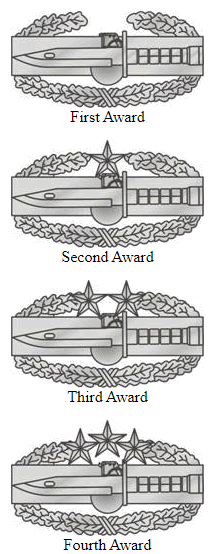
DESCRIPTION:
A silver badge 2 inches (5.08 cm) in width overall consisting of an oak wreath supporting a rectangle bearing a bayonet surmounting a grenade, all silver. Stars are added at the top to indicate subsequent awards; one star for the second award, two stars for the third award and three stars for the fourth award.
SYMBOLISM:
In keeping with the spirit of the Warrior Ethos, the Combat Action Badge (CAB) provides special recognition to Soldiers who personally engage the enemy, or are engaged by the enemy during combat operations. The bayonet and grenade are associated with active combat. The oak wreath symbolizes strength and loyalty.
AWARD ELIGIBILITY:
See Army Regulation 600-8-22, Military Awards.
DATE APPROVED:
On 2 May 2005, the Chief of Staff, Army, approved the creation of the CAB to provide special recognition to soldiers who personally engage, or are engaged by the enemy. HQDA Letter 600-05-1, dated 3 June 2005, announced the establishment of the Combat Action Badge. Changes in the approval authority were approved by the Assistant Secretary of the Army (Manpower and Reserve Affairs) on 24 June 2008.
SUBDUED BADGE:
Subdued badges are authorized in flat black metal finishes.
MINATURE BADGES:
A dress miniature badge, 13/16 inch (2.06 cm) in width is authorized for wear on the mess uniforms. A miniature badge, 1 3/16 inches (3.02 cm) in width is also authorized in lieu of the regular size badge.
COMBAT INFANTRYMAN BADGES
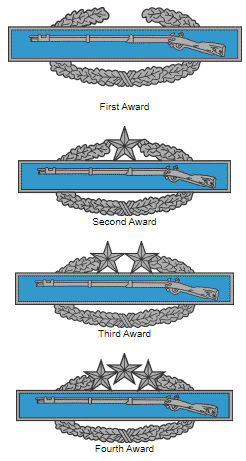
DESCRIPTION: A silver and enamel badge 1 inch in height and 3 inches in width, consisting of an infantry musket on a light blue bar with a silver border, on and over an elliptical oak wreath. Stars are added at the top of the wreath to indicate subsequent awards; one star for the second award, two stars for the third award and three stars for the fourth award.
SYMBOLISM: The bar is blue, the color associated with the Infantry branch. The musket is adapted from the Infantry insignia of branch and represents the first official U.S. shoulder arm, the 1795 model Springfield Arsenal musket. It was adopted as the official Infantry branch insignia in 1924. The oak symbolizes steadfastness, strength and loyalty.
AWARD ELIGIBILITY: Awarded to personnel in the grade of Colonel or below with an infantry or special forces military occupational specialty who have satisfactorily performed duty while assigned as a member of an infantry/special forces unit, brigade or smaller size, during any period subsequent to 6 December 1941 when the unit was engaged in active ground combat. The policy was expanded to permit award to Command Sergeants Major of infantry battalions or brigades, effective 1 December 1967. Specific criteria for each conflict was also established. Only one award is authorized for service in Vietnam, Laos, the Dominican Republic, Korea (subsequent to 4 January 1969), El Salvador, Grenada, Panama, the Southwest Asia and Somalia, regardless of whether an individual has served in one or more of these areas. The complete criteria for each area and inclusive dates are listed in Army Regulation 600-8-22.
DATE APPROVED: The Combat Infantryman Badge was approved by the Secretary of War on 7 October 1943 and announced in War Department Circular 269 dated 27 October 1943. On 8 February 1952, the Chief of Staff, Army, approved a proposal to add stars to the Combat Infantryman Badge to indicate award of the badge in separate wars. Under this change in policy, the badge was no longer limited to a one-time award, but could now be awarded to eligible individuals for each war in which they participated.
SUBDUED BADGES: Subdued badges are authorized in metal and cloth. The metal badge has a black finish. The cloth badge has olive green base cloth with the rifle, wreath, stars and border of the bar embroidered in black.
MINIATURE BADGES: A dress miniature badge, 1 1/4 inches in length is authorized for wear on the mess uniforms. A miniature badge, 1 3/4 inches is also authorized in lieu of the regular size badge.
Combat Medical Badges
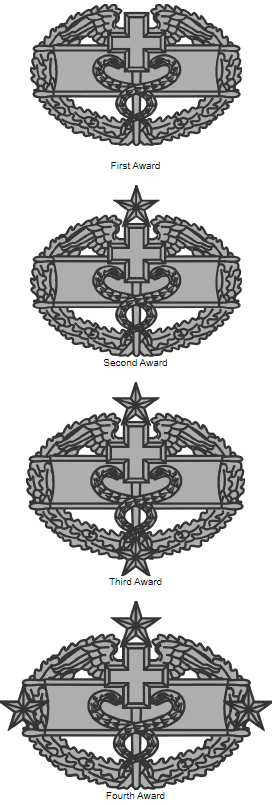
DESCRIPTION: An oxidized silver badge 1 inch in height and 1 ½ inches in width, consisting of a stretcher crossed by a caduceus surmounted at top by a Greek cross, all on and over an elliptical oak wreath. Stars are added to indicate subsequent awards; one star at top for the second award, one star at top and one at bottom for the third award, one star at top and one at each side for the fourth award.
SYMBOLISM: The Medical Corps insignia of branch, modified by the addition of a Greek cross suggesting the Geneva Convention between the wings and the entwined serpents, signifies the recipient’s skills and expertise. It is superimposed upon a stretcher alluding to medical field service. The oak symbolizes steadfastness, strength and loyalty.
AWARD ELIGIBILITY: Awarded to members of the Army Medical Department, Naval Medical Department, Air Force Medical Service or Special Forces Medical Sergeant who are in the grade of Colonel or below while assigned or attached to a medical unit of company or smaller size organic to an infantry/special forces unit during any period the unit was engaged in active ground combat subsequent to 6 December 1941. Only one award is authorized for service in Vietnam, Laos, the Dominican Republic, Korea (subsequent to 4 January 1969), El Salvador, Grenada, Panama, Southwest Asia and Somalia, regardless of whether an individual has served in one or more of these areas. Specific eligibility requirements by geographic area are listed in Army Regulation 600-8-22.
DATE APPROVED: The Combat Medical Badge was approved on 29 January 1945. In February 1951, the proposal to designate the badge as a one-time award was rescinded and it was approved for subsequent award during specified periods. The addition of stars to indicate subsequent awards was also approved.
SUBDUED BADGES: Subdued badges are authorized in metal and cloth. The metal badge is black. The cloth badge has an olive green base cloth with the stretcher, caduceus, cross, wreath and stars embroidered in black.
MINIATURE BADGES: A dress miniature badge, 19/32 inch in height is authorized.
DISTINGUISHED PISTOL SHOT AND RIFLEMAN BADGES
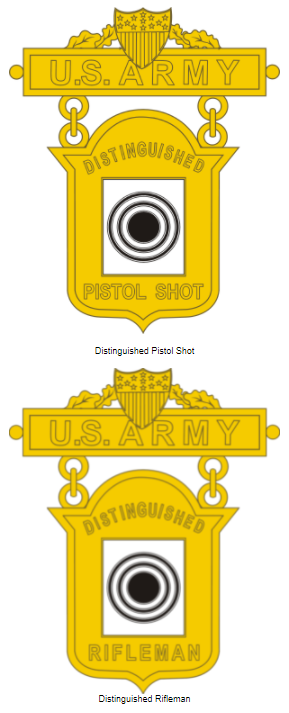
DESCRIPTION:
PISTOL SHOT: A gold badge 2 43/64 inches (6.79 cm) in height overall consisting of a bar and pendant. The bar is 15/32 inch (1.19 cm) in height and 1 1/2 inches (3.81 cm) in width, upon which is superimposed a shield of stars and stripes with the letters "U.S. ARMY" thereon. The pendant is a gold shield shape 1 1/4 inches (3.18 cm) in height and 1 3/64 inches (2.66 cm) in width, in the center is an enameled target between the words "DISTINGUISHED" and "PISTOL SHOT."
RIFLEMAN: A gold badge 2 3/16 inches (5.56 cm) in height overall consisting of a bar and pendant. The bar is 9/16 inch (1.43 cm) in height and 1 13/16 inches (4.60 cm) in width, upon which is superimposed a shield of stars and stripes with the letters "U.S. ARMY" thereon. The pendant is gold shield shape 1 1/2 inches (3.81 cm) in height and 1 13/32 inches (3.57 cm) in width, in the center is an enameled target between the words "DISTINGUISHED" and "RIFLEMAN."
AWARD ELIGIBILITY: A Distinguished Rifleman Badge or a Distinguished Pistol Shot Badge is awarded to a member of the Army in recognition of a preeminent degree of achievement in target practice firing with the military service rifle or pistol. A member of the Army will be designated as a Distinguished Rifleman or Distinguished Pistol Shot when he/she has earned 30 credit points competing in authorized excellence in competition matches. The complete criteria for earning the distinguished designation is found in AR 350-6.
DATE APPROVED: The Distinguished Rifleman Badge was approved by the Secretary of War in General Order 1 dated 3 January 1887 with the Distinguished Pistol Shot Badge being approved in General Order 65 dated 29 April 1903.
SUBDUED BADGES: Subdued badges are not authorized.
MINIATURE BADGES: Miniature badges are not authorized
DIVER BADGES

DESCRIPTION:
a. Scuba: A 1 inch high silver badge consisting of a scuba diver’s hood with face mask, mouthpiece, and breathing tubes. The width is 31/32 inch.
b. Salvage: A silver diving helmet, 1 inch in height, with the letter "S" 3/8 inch in height, superimposed on the chest plate. The width is 23/32 inch.
c. Second Class: A silver diving helmet 1 inch in height. The width is 23/32 inch.
d. First Class: A silver diving helmet 15/16 inch in height, between two dolphins, 1 inch high. The width is 1 3/32 inches.
e. Master: A silver diving helmet 7/8 inch in height in front of a trident 1 1/4 inches in height between two dolphins. The width is 1 3/32 inches.
SYMBOLISM:
a. Scuba: The distinctive equipment of the scuba diver represents the skills and abilities required to qualify for the basic diver rating.
b. Salvage: The diver’s helmet is the basic equipment and the letter "S" is superimposed on the design to reflect salvage activities such as harbor clearance, rock and concrete blasting, steel and timber removal and the removal of propellers for replacement.
c. Second Class: The diver’s helmet is the basic equipment used in diving operations.
d. First Class: The badge includes the design of the diver’s helmet to reflect diving operations and includes the dolphins to suggest the function of diving, without the helmet required of a deep sea diver.
e. Master: The trident is added to the design of the First Class badge which is symbolic of a marine spearhead and stands for valor and strength.
AWARD ELIGIBILITY: The requirements for each award are contained in AR 611-75. Several progressive requirements to attain each level of qualification have been established.
DATE APPROVED: The Second Class, Salvage, First Class and Master Diver Badges were approved on 15 February 1944. The Scuba was approved on 1 May 1969.
SUBDUED BADGES: Subdued badges are authorized in metal and cloth. The metal badge for all designs is black. The cloth badge is of olive green base cloth with outlines of the design embroidered in black with background olive drab.
MINIATURE BADGES: Dress miniature badges are authorized in the following sizes:
a. Scuba: 19/32 inch
b. Salvage: 7/16 inch
c. Second Class: 7/16 inch
d. First Class: 11/16 inch
e. Master: 11/16 inch
DRILL SERGEANT IDENTIFICATION BADGE
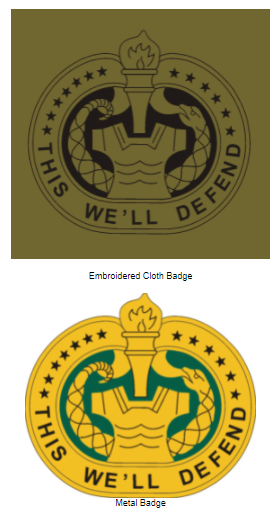
DESCRIPTION:
METAL: A gold plated metal and enamel insignia, 2 inches (5.08 cm) in width and 1 51/64 inches (4.56 cm) in height, consisting of a flaming torch above a breast plate and jupon in front of a rattlesnake on a green background, grasping in its mouth at upper right and with its tail at upper left, the ends of an encircling scroll inscribed "THIS WE'LL DEFEND" in black letters, between 13 black stars, 7 on the left and 6 on the right.
EMBROIDERED: An embroidered insignia, as described above in subdued colors, except the size is 2 3/4 inches (6.99 cm) in width and 2 1/2 inches (6.35 cm) in height. The insignia is on an olive drab square background measuring 3 1/2 inches (8.89 cm) in width and height.
SYMBOLISM: Some elements of the design are adapted from the United States Army Flag and the Seal of the Department of the Army (a snake, the motto and scroll and the armor). Also contained in the design is the torch of liberty and 13 stars.
AWARD ELIGIBILITY:
a. The Commandant of the Drill Sergeant course may award the badge upon successful completion of the Drill Sergeant course and assignment as a drill sergeant to a training command. The Commandant of the Drill Sergeant School will authorize the permanent wear of the badge to eligible personnel by memorandum. Officers are authorized to wear this badge if it was permanently awarded to them while in an enlisted status.
b. The badge may be revoked if the recipient is removed from the position of a drill sergeant for cause, regardless of the amount of time the individual has served in the position in a satisfactory manner. Authority to revoke the badge is delegated to commanders of U.S. Army training centers and commandants of drill sergeant schools. Commanders of U.S. Army training centers may further delegate the revocation authority to commanders in the grade of colonel or higher who have the authority to remove soldiers from drill sergeant duties and withdraw skill qualification identifier (SQI) "X."
WEAR: This badge is authorized as a nonsubdued metal badge and as a subdued embroidered cloth badge. The nonsubdued metal badge will be worn on the right side as prescribed in AR 670-1. The subdued embroidered badge may only be worn on utility uniforms and field jackets with the badge centered on the right breast pocket between the bottom of the pocket flap and the bottom of the pocket or in a similar location on uniforms without pockets. When wearing both the subdued Drill Sergeant and Career Counselor Badges on utility uniforms, the Drill Sergeant Badge will be worn to the right of the Career Counselor Badge.
BACKGROUND: The metal badge was first approved as the distinctive insignia for wear by trainer personnel assigned to U.S. Army Training Activities on 15 January 1958. The insignia for Trainer Personnel was authorized for wear by drill sergeants assigned to training commands in 1964. At this time, the insignia was authorized for wear in metal and embroidered form. The embroidered version was manufactured in full color (yellow, green and black) and subdued. In 1969, policy was changed and it was mandatory to wear subdued insignia on field clothing. At this time, the Drill Sergeant Identification Badge, embroidered, was no longer authorized for wear in full color.
DRIVER AND MECHANIC BADGE

DESCRIPTION: A white metal (silver, nickel and rhodium), 1 inch in height and width, a cross patee with the representation of disk wheel with tire placed on the center.
QUALIFICATION BARS: Bars with the following inscriptions are currently authorized for display on the badges:
OPERATOR - S (for special mechanical equipment)
MECHANIC (for automotive or allied vehicles)
DRIVER - A (for amphibious vehicles)
DRIVER - M (for motorcycles)
DRIVER - T (for tracked vehicles)
DRIVER - W (for wheeled vehicles)
BACKGROUND: The Motor vehicle driver and mechanic award was originally authorized by War Department Circular 248 dated 28 July 1942. The badge is awarded to drivers, mechanics, and special equipment operators to denote the attainment of a high degree of skill in the operation and maintenance of motor vehicles. Specific requirements for award of the badge are contained in AR 600-8-22.
EXPERT FIELD MEDICAL BADGE
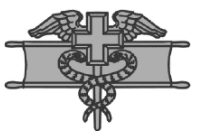
DESCRIPTION: An oxidized silver badge 15/16 inch in height and 1 7/16 inches in width consisting of a stretcher crossed by a caduceus surmounted at top by a Greek cross.
SYMBOLISM: The Medical Corps insignia of branch, modified by the addition of a Greek cross suggesting the Geneva Convention between the wings and the entwined serpents, signifies the recipient’s skills and expertise. It is superimposed upon a stretcher alluding to medical field service.
AWARD ELIGIBILITY: This badge recognizes Army medical personnel for attaining a high state of technical skill in field medical functions. It is awarded on the basis of proven skill and performance. Prior to being awarded the badge, personnel must successfully pass all test parts prescribed by Army Regulations.
DATE APPROVED: The Expert Medical Badge was approved on 18 June 1965.
SUBDUED BADGES: Subdued badges are authorized in metal and cloth. The metal badge is black. The cloth badge has an olive green base cloth with the stretcher, caduceus and cross embroidered in black.
MINIATURE BADGES: A dress miniature badge 9/16-inch in height is authorized.
EXPERT INFANTRYMAN BADGE

DESCRIPTION: A silver and enamel badge 7/16 inch in height and 3 inches in width, consisting of an Infantry musket on a light blue bar with a silver border.
SYMBOLISM: The bar is blue, the color associated with the Infantry branch. The musket is adapted from the Infantry insignia of branch and represents the first official U.S. shoulder arm, 1795 model Springfield Arsenal musket. It was adopted as the official Infantry branch insignia in 1924.
AWARD ELIGIBILITY: Personnel must meet Department of the Army established testing requirements and must possess a military occupational specialty within Career Management Field 11 (Infantry) or 18 (Special Forces), less MOS 18D.
DATE APPROVED: The Expert Infantryman Badge was approved by the Secretary of War on 7 October 1943 and announced in War Department Circular 269 dated 27 October 1943.
SUBDUED BADGE: The subdued badge is authorized in metal and cloth. The metal badge has a black finish. The cloth badge has an olive green base cloth with the rifle and border of the bar embroidered in black.
MINIATURE BADGE: A miniature badge, 1 3/4 inches in length and 3/8 inch in height, is authorized in lieu of the regular size badge. A dress miniature badge, 1 1/4 inches in length and 3/16 inch in height, is also authorized.
EXPLOSIVE ORDNANCE DISPOSAL BADGES
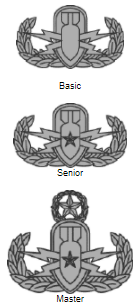
DESCRIPTION: A silver badge, 1 3/4 inches in height, consisting of shield charged with a conventional, drop bomb, point down, from which radiates four lightning flashes, all in front of and contained within a wreath of laurel leaves. The Senior Explosive Ordnance Disposal Badge is the same as the basic badge except the drop bomb bears a 7/32 inch silver star. The Master Explosive Ordnance Disposal Badge is the same as the Senior except a star, surrounded by a laurel wreath, is added above the shield.
SYMBOLISM: The shield charged with a drop bomb is from the shoulder sleeve insignia approved for the Bomb Disposal School in 1942. The device was subsequently adopted for wear on a brassard to identify bomb disposal personnel. The bomb, with point down, indicates a live bomb and with the shield reflects the functions of ordnance personnel to safely dispose of live ordnance.
AWARD ELIGIBILITY: The specific criteria for award of the Explosive Ordnance Disposal Badges is included in AR 600-8-22, all badges require assignment to specific TOE/TDA EOD positions and recommendation by the commander, in addition to the following:
a. Explosive Ordnance Disposal (EOD) Badge: Must have MOS 55D (enlisted) or 91E (officer), complete prescribed instruction and perform satisfactorily for 18 months for the award to become permanent.
b. Senior Explosive Ordnance Disposal Badge: Must have been awarded the basic EOD Badge and (effective 1 May 1989) have served 36 cumulative months in an EOD position following award of the basic badge.
c. Master Explosive Ordnance Disposal Badge: Must have been awarded the Senior EOD Badge and served 60 months in a TOE/TDA officer of NCO EOD position, since award of the senior badge.
DATE APPROVED: The Chief of Staff, U.S. Army, approved the Explosive Ordnance Disposal Specialist and the Explosive Ordnance Disposal Supervisor Badges on 31 July 1957. In June 1969, the Master EOD Badge was authorized. At the same time, the designation of the supervisor’s badge was changed to Senior EOD Badge and the EOD Specialist Badge was changed to EOD Badge.
SUBDUED BADGE: The subdued badge is authorized in metal and cloth. The metal badges have a black finish. The cloth badges are on an olive green base cloth with the wreath, bomb, lightning flashes and outline of shield embroidered in black. The star on the bomb for the senior and master badges is embroidered olive drab. The wreath and star above the badge for the master is also embroidered black.
MINIATURE BADGES: A dress miniature badge, 7/8 inch wide, is authorized.
FLIGHT SURGEON BADGES
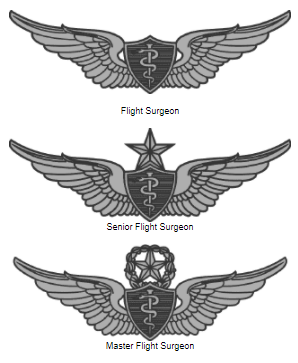
DESCRIPTION: An oxidized silver badge 23/32 inch in height and 2 1/2 inches in width, consisting of a shield, its field scored with horizontal lines and bearing the Staff of Aesculapius on and over a pair of displayed wings. A star is added above the shield to indicate the degree of Senior Flight Surgeon and the star is surrounded with a laurel wreath to indicate the degree of Master Flight Surgeon.
SYMBOLISM: The wings suggest flight and reflect the skills associated with aerial flight. The Staff of Aesculapius is traditionally and historically associated with healing and medical skills.
AWARD ELIGIBIITY: Awarded to any medically qualified Army Medical Corps Officer who satisfactorily completes training and other requirements prescribed in AR 600-105.
DATE APPROVED: The Flight Surgeon Badge (originally approved as the Aviation Medical Officer Badge) was approved on 28 December 1956. The Senior Flight Surgeon (formerly the Flight Surgeon) and Master Flight Surgeon (formerly the Senior Flight Surgeon) Badges were approved on 12 August 1963. The changes in designations were by message from the Commander, U.S. Army Military Personnel Center, 22 November 1973.
SUBDUED BADGES: Subdued badges are authorized in metal and cloth. The metal badge is black. The cloth badge is of olive green base cloth with design elements embroidered in black.
MINIATURE BADGES: Dress miniature badges are authorized in the following sizes: Flight Surgeon – 21/64 inch in height and 1 1/4 inches in width; Senior Flight Surgeon – 13/32 inch in height and 1 1/4 inches in width; Master Fight Surgeon – 15/32 inch in height and 1 1/4 inches in width. Miniature badges are 19/32 inch in height and 2 inches in width; 11/16 inch in height and 2 inches in width; and 23/32 inch in height and 2 inches in width, respectively.
Glider Badge
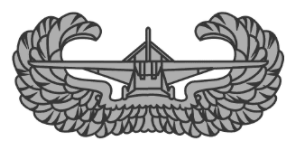
DESCRIPTION: An oxidized silver badge 11/16 inch in height and 1 1/2 inches in width consisting of a glider, frontal view, superimposed upon a pair of stylized wings displayed and curving inward.
SYMBOLISM: The wings suggest flight and together with the glider symbolize individual skills and qualifications in aerial flight utilizing the glider.
AWARD ELIGIBILITY: The Glider Badge is no longer awarded. At the time authorization of the badge was announced, personnel must have been assigned or attached to a glider or airborne unit or to the Airborne Department of the Infantry School; satisfactorily completed a course of instruction, or participated in at least one combat glider landing into enemy-held territory.
DATE APPROVED: Authorization of the Glider Badge was announced in War Department Circular No. 220, 2 June 1944.
SUBDUED BADGES: A subdued badge in black metal finished of the same design is authorized.
MINIATURE BADGES: A dress miniature badge, 13/32 inch in height and 7/8 inch in width is authorized.
GUARD, TOMB OF THE UNKNOWN SOLDIER IDENTIFICATION BADGE
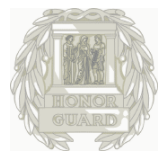
DESCRIPTION: A silver color metal badge 2 inches in width and 1 15/32 inches in height, consisting of an inverted open laurel wreath surmounted by a representation of the front elevation of the Tomb of the Unknown Soldier, the upper section containing the three figures of Peace, Victory, and Valor, the base bearing in two lines the words "HONOR GUARD", all in low relief.
ELIGIBILITY:
a. The Tomb of the Unknown Soldier Identification Badge will be authorized by the Commanding Officer, 1st Battalion (Reinforced), 3d U.S. Infantry (The Old Guard), for wear by each member of the Guard, Tomb of the Unknown Soldier, during their assignment to that duty.
b. Effective 17 Dec 1963, the Commanding Officer, 1st Battalion, 3d U.S. Infantry, may authorize the wearing of the badge as a permanent part of the uniform for personnel who have served honorably for a minimum of 9 months, which need not be continuous, as a member of the Guard, Tomb of the Unknown Soldier, and who are recommended by the Commanding Officer, Honor Guard Company, 1st Battalion, 3d U.S. Infantry.
c. Complete criteria for this Identification Badge may be found in AR 600-8-22.
DATE APPROVED: The Guard, Tomb of the Unknown Soldier Identification badge was established on 9 Sep 1957, by the Honorable Wilbur Brucker, Secretary of the Army.
SUBDUED BADGE: Subdued badges are authorized in cloth. The cloth badge has olive green base cloth with the badge in black and olive green embroidery.
JOINT CHIEFS OF STAFF IDENTIFICATION BADGE
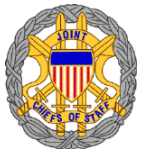
DESCRIPTION.
a. Regular Size: Within an oval silver metal wreath of laurel, 2 1/4 inches in height and 2 inches in width overall, the shield of the United States (the chief in blue enamel and the 13 stripes alternating white and red enamel) superimposed on four gold metal unsheathed swords, two in pale and two in saltire with points to chief, the points and pommels resting on the wreath, the blades and grips entwined with a gold metal continuous scroll surrounding the shield with the word JOINT at the top and the words CHIEFS OF STAFF at the bottom, all in blue enamel letters.
b. Miniature Size: The miniature badge is 1 1/2 inches in height and 1 3/8 inches in width. The design is the same as the regular badge except the shield on the miniature has 9 stripes.
c. Lapel Button: The lapel button is 9/16 inch in height and 1/2 inch in width and is of the same design as the badges except the shield has 5 stripes.
SYMBOLISM. Laurel is symbolic of achievement, courage, and victory. The four unsheathed swords refer to the armed might of the Army, Navy, Air Force, and Marine Corps and their combined constant vigilance and readiness in the defense of the United States.
AWARD ELIGIBILITY. Criteria for the award of the Joint Chiefs of Staff (JCS) Identification Badge are established by JCS Memorandum of Policy (MOP) 142.
DATE APPROVED. Proposed designs were prepared by The Institute of Heraldry and submitted to the Joint Chiefs of Staff on 21 February 1963. On 2 April 1963, the JCS approved a MOP, which established the JCS Identification Badge.
NUCLEAR REACTOR OPERATOR BADGES

(The Army no longer conducts nuclear reactor operations nor nuclear reactor training. Current Army recipients who were permanently award any of the badges may continue to wear it on the Army uniform. AR 672-5-1, dated 1 October 1990, terminated authorization to award the badge.)
DESCRIPTION:
a. Basic: On a 7/8 inch square centered on two horizontal bars each 1/8 inch in width separated by a 3/32 inch square and protruding 1/8 inch from each side of the square, a disc 3/4 inch in diameter bearing the symbol of the planet Uranus all silver colored metal 7/8 inch in height overall.
b. Second Class Operator: The basic badge reduced in size placed on and partially encircled at the base by an open laurel wreath, the ends of the upper bar resting on the tips of the wreath, all of silver colored metal 1 inch in height overall. The areas between the wreath and the basic badge are pierced.
c. First Class Operator: The basic badge reduced in size is placed on and entirely encircled by a closed laurel wreath all of silver colored metal 1 inch in height overall. The areas between the wreath and the basic badge are pierced.
d. Shift Supervisor: The design of the Shift Supervisor Badge is the same as the First Class Operator Badge, except it is gold colored metal.
SYMBOLISM: The square (cube) is used to represent a nuclear reactor, the two bars representing control rods and thus alluding to nuclear reactor operations. The disc is symbolic of completeness and refers to the knowledge and training required of all nuclear reactor operators. The disc is also a symbol of the sun, the source of all energy and power. The symbol of the planet Uranus from which the term "uranium" is derived refers to nuclear energy and power. Addition of the laurel wreaths signifies further achievement and qualification. The gold color for the shift supervisor signifies the highest degree of achievement and qualification.
AWARD ELIGIBILITY: This badge is no longer awarded. To qualify for the basic badge, personnel must have completed a Nuclear Power Plant Operators Course established by AR 350-224 and be able to operate systems of nuclear reactors under the supervision of a certified reactor operator. The Second Class Badge required completion of 15 shifts on a specific nuclear power plant or research reactor. To qualify as a first class operator, the individual must have completed 30 shifts as a trainee first class operator and complete a written examination covering all aspects of operations. The qualifications for shift supervisor required completion of at least 80 shifts as a first class operator and 40 shifts as a trainee shift supervisor, in addition to the written examination.
DATE APPROVED: The badges were approved by the Department of the Army on 18 June 1965.
SUBDUED BADGES: Subdued badges are authorized in metal and cloth. The metal badges are black except the Shift Supervisor Badge, which is brown enamel. The cloth badges are of an olive green base cloth with the disc and extended bars olive drab for all badges. The wreath, square, and device on disc are black for all badges except the Shift Supervisor Badge that is brown.
MINIATURE BADGES: Dress miniature badges for all designs are authorized. The dress miniature badges are ¾ inch wide.
OFFICE OF THE SECRETARY OF DEFENSE IDENTIFICATION BADGE
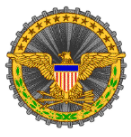
DESCRIPTION:
a. Regular Size: The badge, 2 inches in diameter, consists of an eagle with wings displayed horizontally grasping three crossed arrows all gold bearing on its breast a shield paleways of thirteen pieces argent and gules a chief azure, a gold annulet passing behind the wing tips bearing thirteen gold stars above the eagle and a wreath of laurel and olive in green enamel below the eagle, the whole superimposed on a silver sunburst of 33 rays.
b. The miniature badge is 1 1/2 inches in diameter and is of the same design as the regular size badge except the shield has 9 stripes (5 white and 4 red).
c. The Office of the Secretary of Defense (OSD) lapel button is 37/64 inch in diameter and the shield has five stripes (3 white and 2 red).
SYMBOLISM: The elements on the OSD badge are taken from the Department of Defense seal.
AWARD ELIGIBILITY: Criteria for award of the OSD Identification Badge is established by DOD Directive 1348.13.
DATE APPROVED: The badge was originally approved as the National Military Establishment Identification Badge by the Secretary of Defense per memorandum dated 25 March 1949. It was redesignated the Department of Defense Identification Badge on 28 August 1950. The badge was reestablished and redesignated the Office of the Secretary of Defense Identification Badge by DOD Directive 1348.13 dated 20 December 1962 and authorized for service of not less than one year subsequent to 13 January 1961.
PARACHUTE RIGGER BADGE
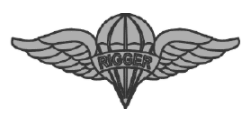
DESCRIPTION: A silver winged hemispherical canopy with conically arrayed cords, 1 3/4 inches wide, with a band centered on the badge inscribed "RIGGER".
SYMBOLISM: The winged parachute represents the functions of rigging of supplies for air drop as well as packing and repair of parachutes used for personnel and cargo.
AWARD ELIGIBILITY: The Parachute Rigger Badge is awarded to soldiers who successfully complete the prescribed course of instruction conducted by the U.S. Army Quartermaster School and have been awarded MOS 43E (enlisted) or 401A (warrant). Officers may be awarded the badge upon completion of a course of instruction prescribed by AR 600-8-22.
DATE APPROVED: The Parachute Rigger Badge was approved by the Chief of Staff, U.S. Army, on 9 June 1986. This approval was retroactive to include personnel who completed the prescribed course of instruction subsequent to May 1951.
SUBDUED BADGE: The subdued badge is authorized in metal and cloth. The metal badges have a black finish. The cloth badge is on an olive green base cloth with the wings, canopy, ropes and letters embroidered in black. The designation band and background between the ropes are embroidered in olive drab.
MINIATURE BADGE: A dress miniature badge, 7/8 inch wide, is authorized.
PARACHUTISTS BADGES

DESCRIPTION: An oxidized silver badge 1 13/64 inches in height and 1 1/2 inches in width, consisting of an open parachute on and over a pair of stylized wings displayed and curving inward. A star and wreath are added above the parachute canopy to indicate the degree of qualification. A star above the canopy indicates a Senior Parachutist; the star surrounded by a laurel wreath indicates a Master Parachutist. Small stars are superimposed on the appropriate badge to indicate combat jumps as follows:
One jump: A bronze star centered on the shroud lines 3/16 inch below the canopy.
Two jumps: A bronze star on the base of each wing.
Three jumps: A bronze star on the base of each wing and one star centered on the shroud lines 3/16 inch below the canopy.
Four jumps: Two bronze stars on the base of each wing.
Five jumps: A gold star centered on the shroud lines 5/16 inch below the canopy.
SYMBOLISM: The wings suggest flight and, together with the open parachute, symbolize individual proficiency and parachute qualifications.
AWARD ELIGIBILITY: Master and Senior Parachutist badges are awarded to individuals rated excellent in character and efficiency who have met the following requirements:
MASTER Parachutist: Participated in 65 jumps to include 25 jumps with combat equipment; four night jumps, one of which is as a jumpmaster of a stick; five mass tactical jumps which culminate in an airborne assault problem with a unit equivalent to a battalion or larger, a separate company/battery, or organic staff of a regiment size or larger; graduated from the Jumpmaster Course; and served in jump status with an airborne unit or other organization authorized parachutists for a total of at least 36 months.
SENIOR Parachutist: Participated in a minimum of 30 jumps to include 15 jumps with combat equipment; two night jumps, one of which is as jumpmaster of a stick; two mass tactical jumps which culminate in an airborne assault problem; graduated from the Jumpmaster Course; and served on jump status with an airborne unit or other organization authorized parachutists for a total of at least 24 months.
PARACHUTIST: Awarded to any individual who has satisfactorily completed the prescribed proficiency tests while assigned or attached to an airborne unit or the Airborne Department of the Infantry School; or participated in at least one combat parachute jump.
DATE APPROVED: The Parachutist Badge was formally approved on 10 March 1941. The senior and master parachutists were authorized by HQDA in 1949 and were announced by C-4, AR 600-70, dated 24 January 1950.
SUBDUED BADGES: Subdued badges are authorized in metal and cloth. The metal badge is black. The cloth badge is of olive green base cloth with the wings, parachute, star and wreath embroidered in black.
MINIATURE BADGES: Dress miniature badges are authorized in the following sizes: Master - 13/16 inch in height and 7/8 inch in width; Senior - 5/8 inch in height and 7/8 inch in width; Parachutist - 15/32 inch in height and 7/8 inch in width.
PATHFINDER BADGE
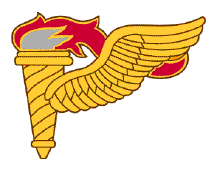
DESCRIPTION: A gold color metal and enamel badge 1 3/16 inches in height and 1 1/2 inches in width, consisting of a gold sinister wing displayed on and over a gold torch with red and gray flames.
SYMBOLISM: The wing suggests flight and airborne capabilities; the torch symbolizes leadership and guidance implying pathfinder combat skills.
AWARD ELIGIBILITY: The Commandant of the U.S. Army Infantry School may award the Pathfinder Badge to any person who successfully completed the Pathfinder Course conducted by that School.
DATE APPROVED: The badge (in felt) was originally approved on 22 May 1964 and was replaced as a metal and enamel item on 11 October 1968.
SUBDUED BADGES: A subdued badge in black metal finish of the same design is authorized.
MINIATURE BADGES: A dress miniature badge, 11/16 inch in height and 7/8 inch in width is authorized.
PHYSICAL FITNESS BADGE
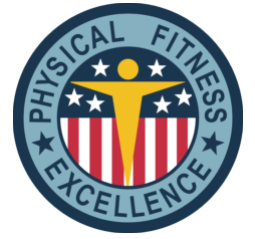
DESCRIPTION: On a dark blue disc 1 5/8 inches (4.13 cm) in diameter edged dark blue; a yellow stylized human figure with arms outstretched in front of a representation of the coat of arms of the United States displaying six stars (three on each side of the figure) and thirteen alternating white and red stripes, all encircled by a brittany blue designation band inscribed "PHYSICAL FITNESS" at top and "EXCELLENCE" below separated on either side by a star, all navy blue; edged with a 1/8 inch (.32 cm) navy blue border. Overall diameter is 2 5/8 inches (6.67 cm).
SYMBOLISM: The inner shield alludes to the coat of arms of the United States. The stylized human figure emphasizes the significance of achieving personnel fitness and physical ability in today's Army.
AWARD ELIGIBILITY: The badge is awarded to soldiers who obtain a minimum score of 290 on the Army Physical Fitness Test (APFT) and meet the weight control requirements in AR 600-9. Once the badge is awarded, it may be retained as long as a minimum passing score is achieved on subsequent APFTs and the weight control requirements are met.
DATE APPROVED: The Physical Fitness Badge was established by the Secretary of the Army on 25 June 1986 and awarded effective 1 October 1986.
WEAR POLICY: The Physical Fitness Badge is authorized only as a cloth badge and will only be worn on the physical fitness uniform. It will be worn centered on the left side, above the breast, of the physical training T-shirt or sweatshirt.
Ranger Tab
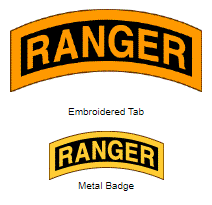
DESCRIPTION: The ranger qualification tab is for wear on the Army green uniform. It is 2 3/8 inches wide with a black embroidered background and yellow embroidered border and letters. A subdued version with olive drab background and border and black letters is authorized for work uniforms.
SYMBOLISM: The colors of the tab were selected to perpetuate a previously authorized ranger shoulder sleeve insignia which was diamond shaped with a deep blue background with yellow border and letters.
AWARD ELIGIBILITY:
a. The Commandant of the U.S. Army Infantry School may award the Ranger Tab to any person who successfully completed a Ranger Course conducted by that school.
b. The Commander, U.S. Total Army Human Resources Command (HRC) and the Commander, U.S. Total Army Reserve Personnel Center (AR-HRC) may award the Ranger Tab to any person who was awarded the Combat Infantryman Badge while serving during World War II as a member of a Ranger Battalion (1st Bn – 6th Bn inclusive) or in the 5307th Composite Unit, Provisional (Merrill’s Maurauders);to any person who was awarded the Combat Infantryman Badge while serving during the Korean Conflict with the 8th Army Ranger Company (11 October 1950 to 27 March 1951); or to any person who successfully completed a Ranger Course conducted by the Ranger Training Command at Fort Benning, GA.
DATE APPROVED: The cloth tab was approved by HQDA on 6 November 1950. Authorization to wear the tab was included in Change 2, AR 600-70, dated 23 January 1953. On 25 November 1984, the Army Chief of Staff approved a metal replica of the embroidered tab for wear on the dress mess uniforms.
SUBDUED TAB: The subdued tab is embroidered with olive drab background and border with black letters. The tab is not authorized in subdued metal.
MINIATURE BADGES: The metal badge authorized for wear on the Army blue or white uniform and green shirt is 1 5/32 inches wide with a black enameled background and gold letters and border. The dress miniature for wear on the mess/dress uniforms is 13/16 inch wide.
SPECIAL FORCES TAB
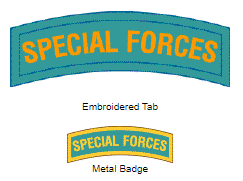
DESCRIPTION: The Special Forces qualification tab is for wear o the Army green uniform is 3 1/4 inches wide with a teal blue embroidered background and border and yellow embroidered letters. A subdued version with olive drab background and borders and black letters is authorized for work uniforms. A metal Special Forces Badge is authorized for wear on the mess/dress uniforms and green shirt.
SYMBOLISM: The colors of the tab are the same colors as the shoulder sleeve insignia authorized for Special Forces Groups.
AWARD ELIGIBILITY:
a. The Commander, U.S. Army John F. Kennedy Special Warfare Center (USAJFKSWC), Fort Bragg, NC 28307-5000, may award the Special Forces Tab to any individual who has successfully completed the Special Forces Qualification Course or the Special Forces Officer Course.
b. The Special Forces Tab may be awarded to any person on active duty, active status in the Reserve Components, in retired status, or honorably discharged who meets the appropriate criteria listed in AR 600-8-22.
DATE APPROVED: The cloth tab was approved by the Army’s Chief of Staff on 17 June 1983, based on a request from the Commander of USAJFKSWC. Criteria, wear policy and authorization to wear the tab was announced in DA Message 061300Z, October 1983, Subject: Special Forces Tab. On 25 November 1984, the Army Chief of Staff approved a metal replica of the embroidered tab for wear on the mess/dress uniforms.
SUBDUED TAB: The subdued tab is embroidered with olive drab background and border with black letters. The tab is not authorized in subdued metal.
MINIATURE BADGES: The metal badge authorized for wear on the Army blue or white uniform and green shirt is 1 9/16 inches wide with a teal blue enameled background and gold letters and border. The dress miniature for wear on the mess/dress uniforms is 1 inch wide.
U.S. ARMY RECRUITER BADGE
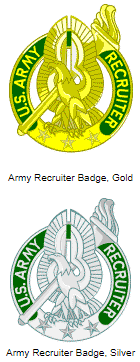
DESCRIPTION: A silver or gold color metal device 2 1/8 inches (5.40cm) in height overall consisting of a circular band inscribed, between two narrow green enamel borders, with the words "U.S. ARMY" on the left and "RECRUITER" on the right, in silver letters, reading clockwise and at bottom center three five-pointed stars; perched upon the inside edge of the band at bottom center an eagle looking to its right its wings raised vertically and extended over the top of the band and supported between its wings diagonally from lower left to upper right a flaming torch with both ends extended outside the band.
SYMBOLISM:The circular band alludes to the continuous need of the Army for young men of quality in its rank. The eagle stands for federal authority and the upraised wings and flaming torch refer to the many opportunities for advancement through education and training offered by the modern Army.
BACKGROUND: The Recruiter Badge was originally approved by the Deputy Chief of Staff for Personnel on 7 Nov 1966. The badge design changed and the modification was approved again by the Deputy Chief of Staff for Personnel on 1 Oct 1974. In 1975, the badge was modified to make the stars detachable. The Department of the Army approved a reduced size of the Recruiter Badge and addition of a sapphire star for the gold Recruiter Badge was approved Sep 1981.
AWARD ELIGIBILITY:
a. The Basic Recruiter Badge is authorized for wear by military personnel assigned or attached to the U.S. Army Recruiting Command (USAREC) as designated by the CG, USAREC, in approved supplementation of the AR 600-8-22.
(1) Authority for the temporary wear of the Basic Recruiter Badge for designated personnel as a uniform item will be announced by CG, USAREC.
(2) Authority for permanent wear of the Basic Recruiter Badge for eligible personnel as a permanent part of the uniform will be announced by memorandum issued by the Commandant, Recruiting and Retention School as authorized by the CG, USAREC.
(3) One, two or three gold achievement stars may be awarded to eligible personnel meeting the criteria established for each achievement star by the CG, USAREC. The stars will be affixed to the basic badge.
b. The U.S. Army Gold Recruiter Badge is authorized for wear by eligible personnel meeting the criteria established by the CG, USAREC.
(1) One, two or three sapphire achievement stars may be awarded to eligible personnel meeting the criteria established for each achievement star by the CG, USAREC. The stars will be affixed to the gold badge.
(2) Authority for permanent wear of the Gold Recruiter Badge, with or without sapphire achievement stars, for eligible personnel as a permanent part of the uniform will be announced by memorandum issued by recruiting battalion commanders authorized by the CG, USAREC.
c. The CG, USAREC, is delegated authority to revoke award of either of the recruiter badges.
SUBDUED BADGES:
a. Silver: A subdued badge is authorized. The cloth badges are of an olive green base cloth with the band embroidered olive drab. The borders, scroll, letters, stars, eagle and torch are embroidered black.
b. Gold: A subdued badge is authorized. The cloth badges are of a black base cloth with the band and letters embroidered black. The borders, eagle, torch and stars are embroidered olive drab. The scroll is embroidered spruce green.
U.S. ARMY RESERVE RECRUITER (OBSOLETE)
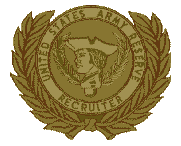
DESCRIPTION: A metal device 2 1/4 inches (5.72cm) in height overall consisting of two circular bands inscribed, within two narrow borders, "UNITED STATES ARMY RESERVE" on the top portion of the circular band reading clockwise, and "RESERVE" on the bottom portion of the band reading counterclockwise. The center displays the U.S. Army Reserve emblem Proper.
BACKGROUND: The U.S. Army Reserve Recruiter Identification Badge no longer exists as a separate identification badge. All Regular Army and Reserve Component recruiters only wear the U.S. Army Recruiter Identification Badge authorized in AR 600-8-22.
WEAPONS QUALIFICATION

DESCRIPTION:
EXPERT: A white metal (silver, nickel and rhodium), 1.17 inches in height, a cross patee with the representation of a target placed on the center thereof and enclosed by a wreath.
SHARPSHOOTER: A white metal (silver, nickel, and rhodium), 1 inch in height, a cross patee with the representation of a target placed on the center thereof.
MARKSMAN: A white metal (silver, nickel, and rhodium), 1 inch in height, a cross patee.
QUALIFICATION BARS: Bars with the following inscriptions are currently authorized for display on the badges:
Rifle
Machinegun
Submachine Gun
Rocket Launcher
Small Bore Pistol
Pistol
Field Artillery
Grenade
Mortar
Missile
AA Artillery
Tank Weapons
Carbine
Bayonet
Aeroweapons
Auto Rifle
Flamethrower
Recoilless Rifle
Small Bore Rifle
Inscription formerly authorized on qualification bars:
1921
Rifle - A
Automatic Rifle
C.A. Gunner
1922
Added Sword
Rifle - B
Pistol
Inf Howitzer
Pistol - M
Rifle - C
Machine Gun
F.A. Gunner
Pistol - D
Rifle - D
Mine Gunner
Delete Pistol
1924
Consolidated all rifles to Rifle, added Machine Rifle, Tank Weapons, C.W.S. Weapons, Bayonet
1926
Added Aerial Gunner, Aerial Bomber
1928
Added Grenade
1941
Deleted Sword, added Small Bore Rifle, Small Bore Pistol, Submachine Gun, Small Bore MG.
1944
Added Carbine, Antitank, 81mm Mortar, 60 mm Mortar, TD 75mm, TD 57mm, TD 3 inch
1948
Added Recoilless Rifle, Mortar. Deleted Pistol D, Pistol M, Mines, C.W.S. Weapons, Aerial Gunner, Aerial bomber, Small Bore MG, Antitank, 81mm Mortar, 60mm Mortar, TD (all types)
1951
Added Submarine Mines
1972
Added Aeroweapons
Prior to 1951 regulation, the titles of the badges were Marksman and 2d Class Gunner; Sharpshooter and First Class Gunner and Expert